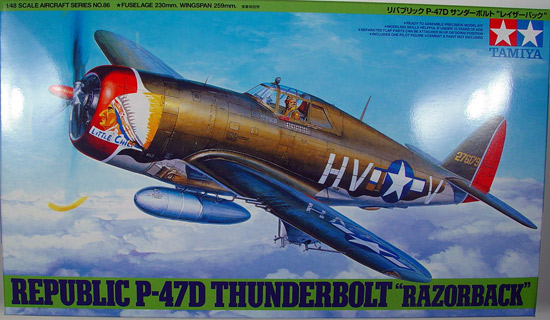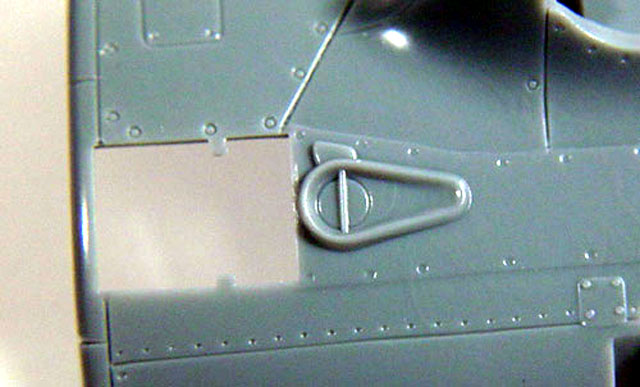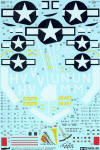|
Republic P-47D Thunderbolt "Razorback"

Tamiya
S
u m m a r y
|
| Catalogue Number
and Description: |
61086 |
| Scale: |
1/48 |
| Price: |
2500 Yen (may
be pre-ordered on Squadron for USD$34.96) |
| Review Type: |
FirstLook |
| Advantages: |
Crisp molding. Appears to be the
most accurate P-47D available. Good selection of ordnance and propellers. |
| Disadvantages: |
Exhaust waste gate could be better.
Typical thick Tamiya decals. |
| Recommendation: |
Recommended |

Tamiya's 1/48
scale P-47D may be ordered online from Squadron
Reviewed by Dave
Williams
Given the number of 1/48 scale P-47 kits
available from the likes of Academy, Hasegawa, and Monogram, many might be
thinking that we need another Thunderbolt like we need another Bf109.
Regardless, Tamiya has always gone their own way and has now entered the fray
with their new kit of the P-47 Razorback. The first impression that the kit is
an excellent rendition of the “Jug” and corrects some of the issues with the
Hasegawa kit. The molding is typical Tamiya: crisp and well-done. I didn’t note
any sink marks and there were only a few ejector pin marks that might need
attention.
The kit provides a number of options a good ordnance selection and a choice of
propellers. Beginning with the ordnance, the kit includes a 150-gal “flat” drop
tank, two 108-gal pressed paper tanks, two 500-lb GP bombs, and two triple tube
4.5-inch rocket launchers. Propeller options include the original 12-foot Curtis
Electric prop and the 13-foot Curtis symmetric paddle blade prop. Also included,
but marked not for use, is the 13-foot Hamilton Standard paddle blade prop. The
propellers have a unique breakdown, being composed of opposing two-blade
sections that are joined together perpendicular to each other to make a
four-blade unit.
Click the
thumbnails below to view larger images:
Starting at the front, the kit has a fairly
good representation of the R-2800 engine, although like most kits, the ignition
wires are notably missing. You get a choice of two magneto styles for the
engine. The two cylinder rows are separate parts and the kit has a good
representation of the divider in the lower nose that diverts the airflow into a
center duct leading back to the turbocharger and two flanking oil coolers. The
actual central duct and oil coolers are molded on the firewall piece that
attaches to the front of the fuselage. The kit has a choice of parts
representing open or closed cowl flaps. It should be noted that the cowl flaps
are of the type with the two lower flaps shorter than the rest which was
standard for all except the early P-47Ds.
Moving on to the fuselage, the louvers for the oil cooler exhaust are separate
pieces inserted from inside the fuselage which allows them to be properly opened
up. Strangely, the exhaust waste gate outlet just aft of the oil cooler outlet
doesn’t seem as well molded as the rest of the kit. The butterfly valve which
controls the exhaust flow is just molded as a recessed circle bisected by a
raised line on the flat fuselage. In reality, the valve was recessed a little
inside the exhaust pipe and the area of the panel just behind the pipe was
dished out a little. This area of the Tamiya kit seems a little flat and
unconvincing to me.

Moving farther back, you have a choice of open of closed
intercooler doors. The fuselage half has a nice section of the curved
intercooler ductwork molded for the open door option, but the duct simply opens
into the big, empty fuselage, so some sort of view blocking device may be
needed. As a contrast, Tamiya provides a turbocharger part to fill in the top of
the turbo exhaust on the belly. One item of note is that Tamiya has molded the
drain lines on the right side of the lower fuselage aft of the wing trailing
edge, which are missing in the Hasegawa kit. Finally, in case anyone is
wondering what the optional parts that look like little reverse scoops placed on
either side of the fuselage below the windscreen are (Parts E6), they are
additional rear view mirrors that were fitted to a few razorbacks in the field.
Although the instructions don’t make any mention, it appears that part E6 could
also be fitted to the top of the windscreen in the normal rear view mirror
position.
The cockpit is nicely done with detailed sidewalls.

The floor is corrugated,
which is correct for razorback P-47s. The instrument panel is really only
designed to work with the included decal as the instruments are simply molded as
raised circles with no actual instrument face detail. Switches and knobs are
molded on the panel, however. The seat has no molded belt detail, however a
decal is provided for the harness. Overall, the kit cockpit is more than
adequate for an out-of-the-box cockpit.
At first glance, the wing parts have a strange breakdown with the ailerons being
molded as part of the upper wing and certain parts of the lower wings as
separate inserts. The inserts on the lower wing, I believe, indicate that a
bubbletop P-47 is in the future. The inserts are for the area behind the
outboard part of the gear bay, where the compressibility flaps would be on
P-47D-30s and up, and for the outboard part of the left wing, where the landing
light was moved to when the compressibility flaps were installed. The right and
left wings are separate parts, designed to slip of stub wing spars that are
placed inside the fuselage. This avoids the step problem some people have
reported with the one-piece lower wing on the Hasegawa kit. The roof of the gear
well extends inboard of the wing root to avoid the seam problem in the Monogram
kit. Tamiya has correctly represented the aileron configuration of the P-47 with
an inset trim tab on the left aileron and an external balance tab on the right
aileron. The flaps are separate parts, with separate sets of actuators for the
up or down positions. The leading edge panel with the holes for the machine guns
is a separate insert and has the guns correctly staggered with relation to the
ground. The gun barrels (or more correctly blast tubes) are individual rods with
a recessed hole to represent the muzzle. Some confusion is possible however, as
both ends of the rods have holes and the instructions show that the end with
slight taper at the tip is the front end. The gun barrels are attached to the
sprue by only one attachment point; unfortunately it is near the visible end of
the barrel, so some careful cleanup will be needed. If using the underwing
pylons or the rocket tubes, holes must be opened up in the wing prior to gluing
the wings halves together. If the pylons are not used, the small strakes that
run forward of the join between the flap and aileron are included as separate
parts. Finally, the cockpit air opening and gun camera port are molded into the
leading edge of the right wing.
Rounding out the kit, the landing gear is nicely done with the upper and lower
gear doors being separate parts. Separate actuating cylinders are provided for
the inner gear doors. The wheel hubs are separate parts and although the kit
only tells you to use the covered hubs, the six-spoke hubs are also present in
the kit. The clear parts are nicely done and include the gunsight and the
internal bulletproof windscreen plate. The canopy is separate from the
windscreen, but it isn’t clear whether it is designed to be placed in the open
position as the instructions do not show this as an option. A clear part is
provided for the underwing landing light, but surprisingly the three recognition
lights under the right wingtip are only represented as circles on the solid
plastic.
 The
kit has a number of “not used” parts, some of which could actually be used on a
razorback Jug. Besides the aforementioned HS prop and six spoke wheel hubs, the
kit contains a DF loop and associated spine fairing which was fitted to some CBI
theater P-47s, a different style of external rear view mirror, and two other
types of gunsights. There is also an extra instrument panel shroud which has a
cutout for a gun sight (unused part F2?) and extends back to cover the top of
the panel. The shroud that is used in the instructions is short and allows the
rear of the instrument panel and gunsight mounting structure to be visible. My
references don’t the long type of shroud being used on a razorback, but it
doesn’t appear to be a bubbletop part as the front is triangular and includes a
slot for the internal bullet proof glass panel just like the part that you are
told to use. The
kit has a number of “not used” parts, some of which could actually be used on a
razorback Jug. Besides the aforementioned HS prop and six spoke wheel hubs, the
kit contains a DF loop and associated spine fairing which was fitted to some CBI
theater P-47s, a different style of external rear view mirror, and two other
types of gunsights. There is also an extra instrument panel shroud which has a
cutout for a gun sight (unused part F2?) and extends back to cover the top of
the panel. The shroud that is used in the instructions is short and allows the
rear of the instrument panel and gunsight mounting structure to be visible. My
references don’t the long type of shroud being used on a razorback, but it
doesn’t appear to be a bubbletop part as the front is triangular and includes a
slot for the internal bullet proof glass panel just like the part that you are
told to use.
Decals are typical Tamiya: nice registration, but a little on the thick side.
Markings are included for two ETO P-47s in OD over Neutral Gray: the popular HV-V
“Little Chief” and UN-M “Spirit of Atlantic City N.J.”
What more can be said that it’s a great kit
with a number of options and great detail overall. Modelers who already own the
Hasegawa kit will have to decide for themselves whether the kit is enough of an
improvement to justify getting one, but the Tamiya is a little bit nicer and
more accurate IMHO.
Recommended.
Kit courtesy of my increasing credit card bill.
Dave Williams
IPMS/USA 19050
Review Copyright © 2001 by Dave
Williams
Page Created 30 November, 2002
Last updated 22 July, 2003
Back to HyperScale
Main Page
Back to Reviews
Page
|
Home | What's
New | Features
| Gallery |
Reviews | Reference
| Forum
| Search